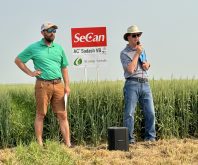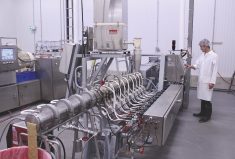Value-added agriculture on the prairies might conjure images of a large-scale industry whose size reflects the immensity of the wheat, lentil and canola fields that stretch as far as the eye can see. And you might think it’s mostly farmers formulating products that add value to what they grow. After all, it sounds so right as a strategy, creating a guaranteed market and price stability. Yet beyond a huge canola crushing industry, the truth is that value-added on the Saskatchewan prairie is more likely to start with a gamble by a local entrepreneur with a good idea or a favourite recipe.
Read Also

Riding the tariff rollercoaster
Farmers are accustomed to roller-coaster years. But the current geopolitical windstorm is something else entirely. On his cattle operation near…
That doesn’t mean the sector is small by any stretch. In 2104, Saskatchewan exported $14 billion worth of agricultural and agri-food products to 153 countries, according to Statistics Canada. Agriculture was 6.5 percent of provincial GDP, and value-added processors shipped $4.3 billion worth of goods. The 2012 Saskatchewan government Plan for Growth: Vision 2020 and Beyond, set a goal for value-added agriculture in the province to increase to $6 billion in 2020, meaning that if current trends continue, those targets might just be achievable.
Somebody clearly will be earning some serious dollars. To support its initiatives, the government established a Ministry of Agriculture Value Added Strategy to conduct market research, develop trade, and attract investment. The whole effort is so new it’s difficult to gauge its success, but today we have over 300 food processing companies employing 5,000 people, and the province’s food and beverage industry makes up 22 percent of total manufacturing and processing output.
And the variety of products is impressive: flour products and bakery mixes; things done with peas, lentils and chickpeas; beef, chicken and pork products; jams, jellies and other preserves; organic cereals and meats; specialty foods, snacks and confections, and the list goes on. From Saskatchewan. Who knew?
Scientists know. Fully one third of Canada’s biotech industry can be found in the province with over 700 scientists in 30 public and private research facilities. Facilities like the Saskatchewan Food Industry Development Centre (Food Centre), a non-profit organization that provides expertise and facilities for entrepreneurs to create products and add value to agriculture.
So who’s involved?
“Everything from mom and pop to multi-nationals,” says Food Centre communications manager, Carmen Ly. “Entrepreneurs come to us for product development, processing, packaging and labelling. Others want further large-scale processing, or require a federally certified facility for exporting.”
With a pilot plant for incubation of an idea/product, to extrusion equipment aimed largely at pulse innovation, and a development kitchen to test recipes and formulations, services are provided at different stages depending on the product. A separate contract is signed for each.
Staff includes food science, culinary and processing experts whose services can also be part of the contract.
“It’s a federally certified facility that is used on a rental basis with project timelines of anywhere from two months to two years or more,” says Ly.
It starts small: Flax to Go
Entrepreneur Kelli Skwark knows the drill. She went to the Food Centre with an idea and a dream and is effusive in her praise of the staff who helped bring her wellness bar, Flax to Go, to the market. After more than 20 years as a dietitian in Winnipeg counselling on the health benefits of flax (cholesterol-lowering omega-3 fatty acid alpha-linolenic acid (ALA), plant lignans and soluble fibre), she and her husband moved to Saskatoon. Instead of carrying on a private practice she decided to make the leap to product development.
“I wanted to make something that uses a good amount of flax, is healthy and convenient, and most importantly tastes good,” she says. Her kitchen became her lab. Skwark spent a year working at different recipes because getting just the right amount of flax in the bar was tricky. She also wanted to incorporate oats and other healthy ingredients. Developed with the Food Centre, the resulting Flax to Go bar contains “nine ingredients you can pronounce, and that’s it,” she says. “It’s vegetarian and naturally gluten free.”

The majority of Skwark’s ingredients come from Saskatchewan farms. The flax and gluten-free oats are milled in Regina, and the honey is from Manitoba via Tisdale, Sask.
“I am sourcing as locally as possible,” she says. “My suppliers provide quality, top-of-the-line product… When I tell people it is locally produced, their eyes light up. People care about that… In Saskatchewan there is so much in terms of food production, and so much potential globally in terms of addressing hunger and in sustainability.”
For a transplant she has a lot of green Saskatchewan pride showing. And she gives credit to many other Saskatchewanians for her success thus far. Like Linda Braun, former executive director of the Saskatchewan Flax Growers Association, who took an early version of Skwark’s flax bar to showcase at an international flax conference, providing feedback Skwark used to make adjustments. From there it was perfected, processed, packaged and labelled at the Food Centre.
That makes it sound like a lark, but as Skwark will tell you it’s a long process. Making a few bars is one thing, but scaling up to full production is quite another. At the Food Centre, Carmen Ly says that after a product is perfected at the pilot plant, it takes a day or two to scale up, tweaking the formulation to work at the larger scale, and ensuring packaging is appropriate for shelf life. Once things have been ironed out, the client is then able to gauge their maximum capacity and a pricing structure.
More help along the way
So that’s production. What about capital? Not everyone can simply go to the bank with a good idea. Like many other Saskatchewan entrepreneurs, Skwark turned for funding and business expertise to the Saskatchewan Agriculture Value Added Initiative (SAVI). It has been run by the province since 2009 under the federal Growing Forward programs. SAVI provides assistance for small- to medium-size agri-businesses — defined as under 250 employees — with information services, business analysis and funding, as well as support for skills and training development.
Developing a business plan was critical to Skwark. “It makes you focus and think through the steps and follow them,” she says. Flax to Go has been on the market since September 2015 and is now in nine Saskatoon locations. Skwark plans to branch out from there using the plan she developed with SAVI, which includes a vision, competitive analysis and risk assessment, costs, distribution, management strategies, and marketing.
“The most successful entrepreneurs are those with a strong business plans,” says Shawn Gibson, program manager with SAVI. “It’s the biggest advantage people can give themselves.”
The program also provides money, up to 50 per cent of the costs for a value-added agricultural business in the province. “Anybody with a good idea and sound banking is eligible as long as they are using Saskatchewan products,” he says. “It’s part of the Saskatchewan Plan for Growth and helps to meet the targets of this program.”
Gibson admits SAVI is a high-risk program. The food industry is very competitive. And it’s not always easy to track success because private enterprise doesn’t always divulge their financials.
“People like the program,” Gibson says. “They mostly accomplish what they’ve set out to do; 80 per cent of people who completed projects were still in business after the Growing Forward 1 program ended in 2012 (the program has continued under GF2). That is very good for a high-risk, food-based business.”
And it grows: Gravelbourg gourmet mustard
Val Michaud took the plunge into that high risk arena, using SAVI funding and expertise to buy and expand her business, Gravelbourg Gourmet Mustard. The slogan for largely bilingual Gravelbourg, Sask., population of 1,100, is A Touch of Europe on the Prairies. Michaud took that phrase to heart, focusing her efforts on providing a variety of otherwise imported gourmet mustards to outlets across the prairies and into British Columbia.
Just as Kelli Skwark has a passion for flax, Michaud sees mustard growing in the fields around her and takes great pride in processing it at home. “It’s so disheartening to see our raw product go to Europe,” she says. “I have a passion to keep it here.”
She certainly does. Michaud bought the business in July of 2011 and by October had developed a 100-recipe cookbook nominated for a top cookbook award. Of the original four products, three were reformulated and she developed two new flavours as well as two dry formulations for rubs. On her own she expanded the business by 75 percent in four years, now producing 30 kgs of each flavour, which amounts to 75,000 jars of mustard. When demand grew, she hired a co-packer to help with supply.

“I’ve never worked harder, physically, in my life,” she says. “There were times when I thought ‘Oh my Lord, what am I doing?’ But the passion remains. When I get comments like ‘it’s the best mustard I’ve tried,’ it makes up for the hardships.”
There are more uses for mustard than you can imagine. Really. “Mustard is not just a hamburger, hotdog thing,” Michaud says. “You can use it in all kinds of ways — in rubs, sauces, dressings, appetizers. Even a mustard martini.” Now that does sound like Europe on the Prairies, doesn’t it?
With numerous retail vendors and a couple of wholesale distributors throughout the West, Michaud says finding more distributors is key to expansion, because distribution is a huge job. And it’s all part of growth.
Another part is finding and using all the resources at her disposal. Michaud has aligned herself with the Saskatchewan Mustard Development Commission. And besides using the services of first the Food Centre and then SAVI, she is a member of STEP, the Saskatchewan Trade and Export Partnership, an organization she says assisted her expansion to different provinces and one she hopes will help as she looks to exporting outside the country.
Back in Saskatoon, Kelli Skwark says her work with the Flax to Go bar has been a team effort and she suggests that anyone venturing into value-added endeavours would be well advised to seek and accept help from anyone with something to offer. “I’m just a little part of the team,” she says. “I’m grateful. I made a call. You take that chance and who knows, you might get a positive response. One door opens, and then another… It’s been a wonderful learning experience.”
There is no manual for this, though Skwark says one would be very helpful. But she has managed to meet like-minded people who share ideas. “It can save you a lot of money and time if you’ve got a core group of people who help one another.”
While Val Michaud’s challenges with her gourmet mustard are now more business related, one of Skwark’s biggest challenges is being patient. “You have to let the journey take its course and realize that everyone has to go through it,” she says. “Stick with it. Talk to people and realize that ‘my beginning is not the same as someone else’s middle’.”
Beginning, middle or end, what these value-adding entrepreneurs hold in common is a desire to use the resources of the prairie fields that surround them, to add value, to be their own boss and to dream big. Part of the Saskatchewan Plan for Growth? Not entirely, but they just might be the ones making it happen.















